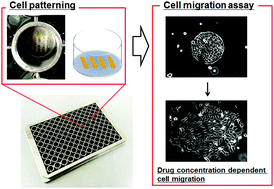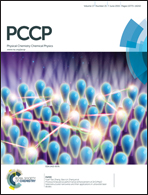Facile preparation of a photoactivatable surface on a 96-well plate: a versatile and multiplex cell migration assay platform
Abstract
Cell migration is an essential cellular activity in various physiological and pathological processes, such as wound healing and cancer metastasis. Therefore, in vitro cell migration assays are important not only for fundamental biological studies but also for evaluating potential drugs that control cell migration activity in medical applications. In this regard, robust control over cell migrating microenvironments is critical for reliable and quantitative analysis as cell migration is highly dependent upon the microenvironments. Here, we developed a facile method for making a commercial glass-bottom 96-well plate photoactivatable for cell adhesion, aiming to develop a versatile and multiplex cell migration assay platform. Cationic poly-D-lysine was adsorbed to the anionic glass surface via electrostatic interactions and, subsequently, functionalized with poly(ethylene glycol) (PEG) bearing a photocleavable reactive group. The initial PEGylated surface is non-cell-adhesive. However, upon near-ultraviolet (UV) irradiation, the photorelease of PEG switches the surface from non-biofouling to cell-adhesive. With this platform, we assayed cell migration in the following procedure: (1) create cell-attaching regions of precise geometries by controlled photoirradiation, (2) seed cells to allow them to attach selectively to the irradiated regions, (3) expose UV light to the remaining PEGylated regions to extend the cell-adhesive area, (4) analyse cell migration using microscopy. Surface modification of the glass surface was characterized by ζ-potential and contact angle measurements. The PEGylated surface showed cell-resistivity and became cell-adhesive upon releasing PEG by near-UV irradiation. The method was applied for parallelly evaluating the effect of model drugs on the migration of epithelial MDCK cells in the multiplexed platform. The dose–response relationship for cytochalasin D treatment on cell migration behavior was successfully evaluated with high reproducibility. Interestingly, the impact of blebbistatin on cell migration was dependent upon the widths of the migrating regions, resulting in both cases of migration acceleration and deceleration. These results clearly demonstrate that the cellular response to certain drugs is highly affected by their migrating geometries. Therefore, the obtained novel photoactivatable 96-well plate serves as a useful high-throughput platform for the identification of drug candidates that have an effect on cell migration behavior.


 Please wait while we load your content...
Please wait while we load your content...